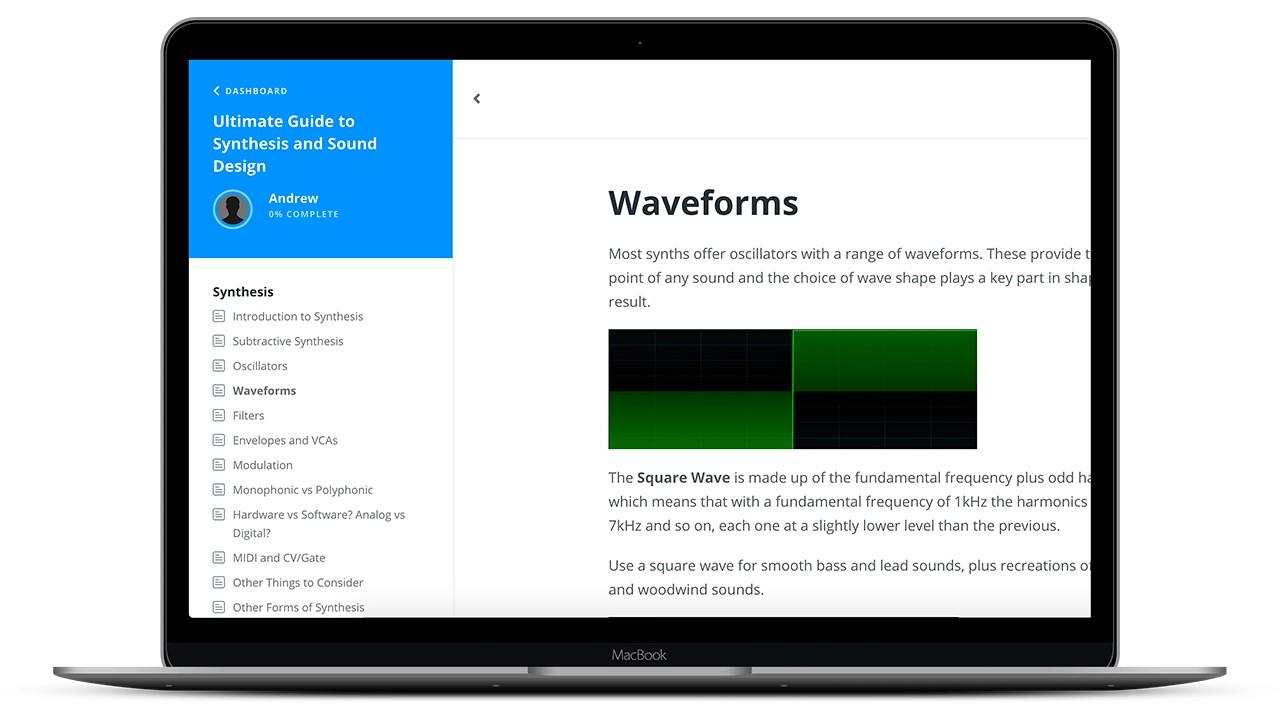The Ultimate Guide to Synthesis and Sound Design
Imagine if you were able to design every sound you hear in your head within minutes…you could finally start writing music that has it’s own unique sound, and other producers would be asking you how you designed your own character sounds.

The Ultimate Guide to Synthesis and Sound Design
Are you concerned there are special tricks other producers know that you don’t? Are you worried that you’ll never be able to develop your own unique sound? Do you get frustrated easily and just end up using presets?
The Ultimate Guide to Synthesis and Sound Design will massively expand your sound design skills and give you total confidence to open any synthesizer and start using it right away. You’ll know how to intuitively manipulate and maneuver key components of any synth, using techniques that professional sound designers usually keep secret.

Areas of Study
- Gain-staging – optimising the signal flow in your mix, reducing distortion and preserving dynamic range.
- Phase – dealing with offset issues as well as effects and creative use.
- Panning – Giving separation and focus to elements in the mix plus some creative tips & tricks.
- Stereo Width and Depth – Enhancing the left to right and front to back image to create better stereophonic mixes.
- Meters – Using tools to help us visually read our mix, measuring actual loudness as we hear it and the various standards used in metering tools.
By focusing on these areas when approaching a mix you will develop a more effective workflow leading to a better more consistent mix every time.
- Learn at your own pace, watch as many times as you need to learn the lessons
- 6 in-depth modules each focused on integral elements of every mix
Chapter 1 - Synthesis
Not only are synths able to create practically every sound the dance producer will ever need - from bass and leads to pads, drums and FX - they can also be used to process vocals and other real-world sounds.
The first devices that generated sounds using electric circuits can be dated back to the late 19th century. But it wasn't until the early 1960s that primitive synthesizers started to take off as instruments takes to the work of pioneers like Bob Moog and Don Buncha, who created the first commercially available synthesizers and laid the ground work for the countless other designers and manufacturers that followed.
What is synthesis? In simple terms, it's the process of creating a sound from scratch electronically. While acoustic instruments like guitars, pianos, and violins generate sound acoustically through a physical process of plucking, striking or bowing strings, synths are entirely electrical.
Nowadays, we can take our pick form thousands of synths - either analog or digital, hardware or software - but in the early years of synthesis, the options were invariably analog using a method known as subtractive synthesis. The same method dominates the synth world today.

Chapter 2 - Mixing Preparation
In this section we will look at some things that you need to think about before you set out to mix a track.

Chapter 3 - Mixer Usage
Having spent some time working on prerequisites, we will now move into issues directly related to mixing.

Chapter 4 - Equalization
In this chapter, we arrive at the next big topic in mixing: that of equalization. Equalization, or EQ, is the process of changing the balance of the frequency components of sounds.

Chapter 5 - Compression
Compression is the process of shaping the dynamics of sounds. A compressor is an automated volume control. It automatically adjusts the volume of the input signal in response to changes in volume in the signal itself.
Compressors are difficult to learn to use, for several reasons. They have many different and unrelated purposes. They have complex mechanics of operation, and it is necessary to understand these mechanics in order to operate them. Their effect on the sound is not always readily audible. And finally, the specific things that one has to do to get good results out of them are routinely very different from what one would intuitively expect.

Chapter 6 - Space Manipulation
The sound in a stereo audio recording can be seen as being arranged in a three dimensional “sound stage.”
A sound does not usually occupy a single point on any of these axes; rather, it is a three-dimensional “blob” in the sound space.
The X (width) axis of the sound stage is stereo position.
The Y (height) axis is pitch, with higher-pitched sounds appearing higher in the sound stage.
Finally, the Z (depth) axis is distance, with more prominent sounds appearing closer to the front of the sound stage.
In this section, we will look at the tools that allow one to manipulate the sound stage; to move sounds forward, back, and to the sides in the mix. We will not consider how to move a sound up or down in the mix.


